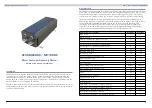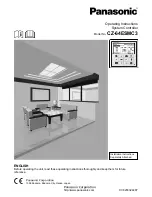
Zero Emission Vehicles Australia
Motor Controller Assembly Manual
• Fit the end panel over the busbars then solder all wires to the logic board. Ideally twist the
two CAN bus wires around each other a couple of times on the way (helps with noise
immunity).
Programming
• Wire up the power/CAN connector with 12V and Ground wires, and apply 12V using a
current limited power supply. The programming port on the logic board is a different pin
layout to normal AVRISP header, having a single row of 5 pins ordered GND, MOSI, MISO,
SCK, RESET, so you will need to make an adapter from your programmer. Fuses should be set
to 4.2V brownout, CKDIV8 off, and external 8Mhz crystal with 0ms startup time. AVR/
Microchip Studio or AVR Dude may be used to set the fuses and transfer the firmware.
Congratulations, your motor controller should now be ready to run!
(But let’s do some testing before you put it in a vehicle.)
Testing
• Apply 12V to the power/CAN connector from a current limited variable power supply, and
the status LED should light up blue. Apply 12V to the B+ and B- power terminals and the LED
should turn green.
• Check the current sensor level from the interface board (it should be 2.5V) and the
temperature sensor level should also be about 2.5V (a bit more if hot, a bit less if cold).
• Fit the 4-pin throttle connector to a suitable 0-5V 3-wire + enable throttle. A 5kohm
potentiometer can be used, with Enable wired permanently to 5V. Set the throttle to about
20%, then use an oscilloscope to check that every transistor gate has a 12V square wave. The
oscilloscope ground lead can be clipped to one of the screws along the B- busbar.
• Disconnect the 12V wires from the power terminals. Ideally now test with a 12V-150V
battery attached to the B-/B+ terminals and a motor attached to the M-/M+ terminals, but note
that you will need to precharger the controller (e.g using a 50ohm 10W resistor in series)
before attaching the battery terminals, and make sure you have a suitable fuse between the
battery and controller. Alternatively, at this point you may wish to carefully test it in the
vehicle. For initial testing, a fuse of about 50A and an unloaded motor is recommended.
Boxing up the controller
• This may vary depending on what sort of housing you are using, but in general you will need
to apply a thin layer of thermal paste to the top of the heat block before fastening it to your
heatsink or housing with 2 or 3 M6x20 countersunk machine screws. If using an original ZEVA
extruded housing, the end plates attach to the housing using 4x M3x10 countersunk machine
screws each.
• Application of Noalox or other contact grease is recommended on the power terminals to
prevent oxidation which increases contact resistance and causes heating.
11
12
























